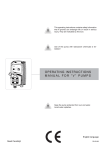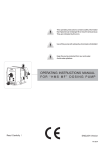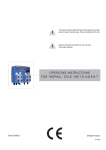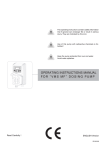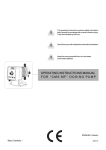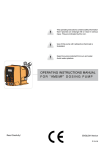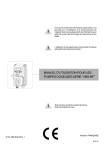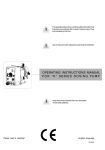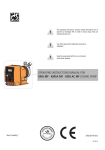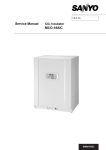Download OPERATING INSTRUCTIONS MANUAL FOR “V” PUMPS
Transcript
This operating instructions contains safety information that if ignored can endanger life or result in serious injury. They are indicated by this icon. Use of this pump with radioactive chemicals is forbidden! OPERATING INSTRUCTIONS MANUAL FOR “V” PUMPS Keep the pump protected from sun and water. Avoid water splashes. English language Read Carefully! 1 R1-05-06 “V” series solenoid dosing pumps comply with the following European regulations: EN60335-1 : 1995, EN55014, EN50081-1/2, EN50082-1/2, EN6055-2, EN60555,3 Based on directive CEE 73/23 c 93/68 (DBT Low voltage directive) and directive 89/ 336/CEE (EMC Electromagnetic Compatibility) GENERAL SAFETY GUIDELINES Danger! In emergencies the pump should be switched off immediately! Disconnect the power cable from the power supply! When using pump with aggressive chemicals observe the regulations concerning the transport and storage of aggressive fluids! When installing always observe national regulations! Manufacturer is not liable for any unauthorized use or misuse of this product that may cause injury, damage to persons or materials. Caution! Pump must be accessible at all times for both operating and servicing. Access must not be obstructed in any way! Feeder should be interlocked with a no-flow protection device. Pump and accessories must be serviced and repaired by qualified and authorized personnel only! Always discharge the liquid end before servicing the pump! Empty and rinse the liquid end before work on a pump which has been used with hazardous or unknown chemicals! Always read chemical safety datasheet! Always wear protective clothing when handling hazardous or unknown chemicals! 2 1. Introduction Introduction: “V” Series metering pumps are the ideal solution for low / middle dosing of chemicals. All control and setup parameters are available using accurate control knobs and a visual system (led). “V” Series metering pumps have digital On/Off switch to ensure dosing activities (available on some models only). Pump capacity: Flow rate is determined by the stroke speed (frequency) adjustment. The stroke speed is adjustable from 0 to 100% using the adjustment knob. However dosing accuracy is guarantee within an adjustment range from 30% to 100%. The led on the panel shows the status activity of the pump. 3 2. Unpacking Included into package: n.2 n.2 n.1 n.1 n.1 n. 1 m2 m2 m2 n.1 Dibbles ø6 Self tapping screws 4,5 x 40 Delayed fuse 5 X 20 Foot filter with valve Injection valve Level probe (not included in VCO model) Delivery pipe* (opaque PE) Suction pipe * (transparent PVC) Discharge pipe (transparent PVC 4x6) This installation manual * If hose is 6x8 then there is only a 4mt long hose. Cut to obtain suction and delivery hoses. PLEASE DO NOT TRASH PACKAGING. IT CAN BE USED TO RETURN THE PUMP. 4 3. General description On/Off button On/Off Led - Pump’s pulses Stroke speed knob Delivery valve Discharge knob Power supply Suction valve Level Probe Input Note: Shown image does not represent a specific pump’s model. It is only for general purpose. 5 4. Before to Install warnings Pump’s installation and operativity is performed in 4 main steps: Pump’s installation Hydraulic Installation (hoses, level probe, injection valve) Electrical Installation (main power connection, priming) Programming the pump. Before to start, please read carefully the following safety information. IProtective clothes Wear always protective clothes as masks, gloves, safety glasses and further security devices during ALL installation procedure and while handling chemicals. Installation location Pump must be installed in a safety place and fixed to the table / wall to avoid vibration problems! Pump must be installed in a easy accessible place! Pump must be installed in horizontal position! Avoid water splashes and direct sun! Hoses and Valves Suction and delivery hoses must be installed in horizontal position! All hoses connections must be performed using only hands’ force! No tongs required! Delivery hose must be firmly fixed to avoid suddenly movements that could damage near objects! Suction hose must be shorter as possible and installed in vertical position to avoid air bubbles suction! Use only hoses compatibles with product to dose! See chemical compatibility table. If dosing product is not listed please consult full Compatibility Table or contact chemical’s manufacturer! 6 5. Installation draw Pump must be installed in a stable support at a maximum height (from tank’s bottom) of 1,5 meters. 4 3 1 8 2 5 6 1 - Dosing Pump 2 - Suction Hose 3 - Delivery Hose 4 - Injection Valve 5 - Air discharge 6 - Level Probe 7 - Foot Filter 8 - Power Cable 7 7 6. Hydraulic Installation Hydraulic connections are: Suction Hose with level probe and foot filter Delivery Hose with injection valve Discharge Hose Suction Hose. Completely unscrew tightening nut from pump’s head and remove assembling components: tightening nut, holding ring and pipe holder. Assembly as shown in fig. (A). Insert hose into pipe holder until it reaches the bottom. Lock hose on pump’s head by screwing down the tightening nut. Use only hands to do it! Connect other side of the hose to the foot filter using the same procedure. Suction Hose Tightening Nut Holding Ring Pipe Holder O-ring Valve fig. (A) 8 6. Hydraulic Installation Assembling foot filter with level probe. Level probe must be assembled with foot filter using the provided kit. Foot valve is made to be installed into tank’s bottom without sediments priming problem. Completely unscrew level probe’s nut and assembly as described in fig. (B) paying attention to the black ring: it must be inserted from floater side. Lock nut on the opposite side of the floater using hands only. to BNC connector (pump’s level input) to suction hose level probe black ring fixing nut foot filter fig. (B) Connect BNC from level probe into pump’s level input (front side of the pump). Put level probe assembled with foot filter into tank’s bottom. Warning: If there is a mixer installed into tank, install a suction lance instead of level probe / foot filter. Delivery Hose. Completely unscrew tightening nut from pump’s head and remove assembling components: tightening nut, holding ring and pipe holder. Assembly as shown in fig. (A). Insert hose into pipe holder until it reaches the bottom. Lock hose on pump’s head by screwing down the tightening nut. Use only hands to do it! Connect other side of the hose to the injection valve using the same procedure. 9 6. Hydraulic installation Injection Valve. Injection valve must be installed on plant from water’s input. Injection valve will open at pressure greater than 0,3bar. Discharge hose. Insert one side of discharge hose into discharge connector as shown in fig (C). Insert other side of discharge hose into product’s tank. During priming procedure product exceeding will flow into tank. To Delivery hose Discharge Knob Discharge hose To Suction hose fig (C) For priming procedure see the related chapter. 10 6. Hydraulic installation Self-venting pump head. to discharge hose to delivery hose to suction hose Self-venting pump head must be used when using chemicals that produce gas (i.e. hydrogen peroxide, ammonium, sodium hypoclorite at particular conditions). Hoses assembling procedure (including purge hose) is described in fig. (A). Notes: - suction, delivery and purge valves are DIFFERENT! Do not exchange them! - delivery and purge hoses are made of same material! - it’s allowed to lightly bend discharge hose! - during calibration procedure (“TEST”) insert discharge hose into BECKER test-tube! 11 7. Electrical installation All electrical connections must be performed by AUTHORIZED AND QUALIFIED personnel only. Before to proceed, please, verify the following steps: - verify that pump’s label values are compatible with main power supply. - pump must be connected to a plant with a differential switch (0,03A sensitivity) if there isn’t a good ground. - to avoid damages to the pump do not install it in parallel with heavy inductance load (for example: engines). A relay switch must be used. See below picture. P - Dosing Pump R - Relay I - Switch or safety device E - Electrovalve or inductance load A - Main Power - On pump’s mother board there is a further protection against over voltages (275V - 150V) and distribution line noises (4KV for max 50µsec) as shown: 12 7. Electrical Installation Once verified previous steps proceed as follows: - check that “BNC” of level probe has been connected as described in “Hydraulic Installation” chapter. - connect “BNC” and external signal to pump’s “INPUT” connectors. Level Probe Input 1 (bottom view) 1 Level Probe Input available on: VCL 13 8. Models LEVEL ALARM CL type pumps are provided with a liquid level alarm to indicate product tank is empty. The level probe is connected to the right BNC plug on pump’s bottom panel. The level probe is made of a N.O. reed contact (10VA, 1A max., 230Vac max.) closed by a floating magnet housed in a (PP) plastic box. When the product level goes below the minimum the magnet closes the reed contact. The pump stops and the red LED on pump’s front panel indicates the alarm status. PUMP TYPES Pumps mod. “VCLF” and “VCL” (12-24 Vac/Vdc) are equipped with a bicolour led. Led on, red colour: low level product alarm. Check product’s tank and restore the level. Led on, blinking green colour: pump normal operating mode. Led on, blinking green colour (one second on, one second off): power supply out of range. Check pump’s label and check the main power. 14 8. Models VCO Constant pump with flow control (front panel knob may be set from 0% to 100% of pump nominal capacity). Flow control is electronically set and it operates on pump injections number. To avoid linearity problem do not set the knob of pump flow between 0% and 10%. VCO may operate in constant dosing mode or On-Off mode (using an external signal). Dosing example using an VCO 0505: to dose 2,5 l/h at 5bar counter-pressure rotate front panel knob to 50%. VCO has a divider (x- 0,1) to reduce by ten times the pump capacity by dividing the pump stroke speed. How to enable “divider mode”: - set the pump into STANDBY* mode; - keeping pressed the on/off button, wait 3 flashes from the status led. The pump will start the dosing activity with the stroke speed reduced ten times than the value set on stroke lenght knob. To disable the “divider mode”, power OFF the pump. Keeping pressed the on/off button, wait 3 flashes of the status led. N/OF F on/off button O VCO 30 20 40 50 60 10 0 status led 70 80 stroke lenght knob 90 100 % LED The led on the frontal panel shows the pump’s operating status through four flashing: LED ACTIVITY PUMP’S STATUS It flashes 3 times per second the pump is powered with a power supply lower than the label It flashes 2 times per second the pump is powered with a power supply higher than the label It flashes 1 time per second the pump is in pause (OFF) and it is powered led ON, it switches off 1 time per second the pump is active and functioning (ON) 15 8. Models VCL Constant dosing pump with level alarm. A red led indicates that the product’s tank is empty. During this condition the pump does not dose. The pump has flow control (front panel knob may be set from 0% to 100% of pump nominal capacity). Flow control is electronically set and it operates on pump injections number. To avoid linearity problem do not set the knob of pump flow between 0% and 10%. VCL has a divider (x- 0,1) to reduce by ten times the pump capacity by dividing the pump stroke speed. How to enable “divider mode”: - set the pump into STANDBY* mode; - keeping pressed the on/off button, wait 3 flashes from the status led. The pump will start the dosing activity with the stroke speed reduced ten times than the value set on stroke lenght knob. To disable the “divider mode”, power OFF the pump. Keeping pressed the on/off button, wait 3 flashes of the status led. N/OF F on/off button O VC L 30 20 40 50 60 10 0 status led/ level alarm 70 80 stroke lenght knob 90 100 % LED The led on the frontal panel shows the pump’s operating status through four flashing: 16 LED ACTIVITY PUMP’S STATUS It flashes 3 times per second the pump is powered with a power supply lower than the label It flashes 2 times per second the pump is powered with a power supply higher than the label It flashes 1 time per second the pump is in pause (OFF) and it is powered led ON, it switches off 1 time per second the pump is active and functioning (ON) 9. Priming MANUAL PRIMING / DISCHARGING 1. Connect the pump to main power. 2. Rotate front panel knob to 70%. 3. Turn on the pump. 4. Rotate discharge knob (open it completely). 5. The chemical will begin to flow into discharge hose. Close the discharge knob. 6. Proceed to normal operating mode. 17 10. Troubleshooting PROBLEM POSSIBLE CAUSE Pump isn’t powered. Connect it to main supply. Pump doesn’t turn on. Pump’s protection fuse is broken. Replace it. See page 19 for replacement procedure. Pump’s main board is broken. Replace it. See page 19 for replacement procedure. The foot filter is obstructed. Clean it. Suction hose is empty. Pump must be primed. Repeat priming procedure. Pump is not dosing and solenoid is operating. Air bubbles inside hydraulic circuit. Check valves hoses - fittings. Product to dose is generating gas. Turn discharge knob and let air flow away. Use a self-venting pump head. Pump is not dosing and solenoid isn’t operating or slightly operating. Crystals presence inside valves. Check them and try to dose 2-3 liters of normal water. Change valves. Injection valve obstructed. Change it. 18 11. Fuse and main board replacement Fuse or main board replacement is allowed to qualified personnel only. Before to operate disconnect the pump from main power and all hydraulic connections. For fuse replacement is necessary to use a 3x16 and 3x15 screwdriver and a new fuse (same model of old one). For main board replacement is necessary to use a 3x16 and 3x15 screwdriver and a new main board (same model of old one). Fuse replacement procedure: - Turn pump’s injection knob on 0%. - Remove 6 screws from pump’s back. - Pull pump’s back cover until it’s completed separated from pump’s front. Be careful of the knob’s spring. - Locate the blown fuse and replace it. - Reassemble the pump. Be careful to put back the knob’s spring. - Reinsert screws. Main board replacement procedure: - Turn pump’s injection knob on 0%. - Remove 6 screws from pump’s back. - Pull pump’s back cover until it’s completed separated from pump’s front. Be careful of the knob’s spring. - Remove board’s screws. - Completely disconnect wires from main board and replace it. Reinsert screws. - Reconnect wires to the main board (see enclosed picture). - Reassemble the pump. Be careful to put back the knob’s spring. - Reinsert screws. 19 FUSE 12. Main board N L Power supply Solenoid FUSE Mod. VCO + L N Power supply Level Solenoid Mod. VCL 20 A Appendix. Maintenance. During normal operating mode, pump must be checked once for month. Wear needed safety devices and check hoses and all hydraulic components for: - product leak - broken hoses - corroded connections All maintenance operations must be performed by authorized and trained personnel only. If pump needs factory assistance please use original package to return it. Before to do it, please, remove all dosing product inside the pump and hoses. Use only original spare parts! 21 B Appendix. Construction Materials and Technical info TECHNICAL FEATURES Power Power Power Power supply: supply: supply: supply: 230 VAC (190-265 VAC) 115 VAC (90-135 VAC) 24 VAC (20-32 VAC) 12 VDC (10-16 VDC) Pump strokes: 0 ÷ 180 Suction Height: 1,5 metres Environment Temperature: 0 ÷ 45°C (32 ÷ 113°F) Chemical Temperature: 0 ÷ 50°C (32 ÷ 122°F) Installation Class: II Pollution Level: 2 Audible Noise: 74dbA Packaging and Transporting Temperature: -10÷+50°C (14 ÷ 122°F) Protection degree IP65 MANUFACTURING MATERIALS Case: Pump head: Diaphragm: Balls: Suction Pipe Delivery Pipe: Valve Body: O-ring: Injection connector Level Probe: Level probe cable: Foot Filter: PPO PVDF PTFE CERAMIC, GLASS, PTFE, SS * PVC PE PVDF FP, EP, WAX, SI, PTFE * PP, PVDF (glass, HASTELLOY C276 spring) PP, PVDF * PE PP, PVDF * * as ordered. Flow Max Capacity l/h Max Pressure bar ml stroke Strokes/ min Hoses mm Fuse at 230 VAC Fuse at 115 VAC Watt W Shipping weight Kg 20 01 1 20 0.09 180 4x8 630 mA 315 mA 16 2.2 18 02 2 18 0.19 180 4x8 800 mA 500 mA 16 2.2 18 04 4 18 0.37 180 4x8 800 mA 630 mA 22 2.2 15 02 2 15 0.19 180 4x6 630 mA 315 mA 16 2.2 15 04 4 15 0.37 180 4x6 800 mA 500 mA 16 2.2 15 05 5 15 0.46 180 4x6 800 mA 630 mA 22 2.2 10 04 4 10 0.37 180 4x6 630 mA 315 mA 16 2.2 10 05 5 10 0.46 180 4x6 800 mA 500 mA 16 2.2 10 10 10 10 0.93 180 4x6 800 mA 630 mA 22 2.2 07 06 6 7 0.56 180 4x6 630 mA 315 mA 16 2.2 05 10 10 5 0.93 180 4x6 800 mA 500 mA 16 2.2 05 12 12 5 1.11 180 4x6 800 mA 630 mA 22 2.2 04 08 8 4 0.74 180 4x6 630 mA 315 mA 16 2.2 03 10 10 3 0.93 180 4x6 630 mA 315 mA 16 2.2 02 14 14 2 1.30 180 4x6 800 mA 500 mA 16 2.2 01 16 16 1 1.48 180 4x6 800 mA 500 mA 16 2.2 22 C Appendix. Delivery Curves Pump Head K Pump Head J 20 01 L/h 18 02 l/h 02 l/h 01 bar bar 20 Pump Head K L/h 15 02 l/h 02 bar 15 l/h 05 bar 10 bar bar 15 Pump Head K 05 L/h bar l/h 04 10 bar bar 18 Pump Head K 15 04 L/h Pump Head K L/h 10 04 bar L/h l/h 04 bar 10 bar 23 C Appendix. Delivery Curves Pump Head K 05 10 Pump Head K 04 08 L/h l/h 10 bar bar 05 L/h bar l/h 08 bar 04 Pump Head K Pump Head K 01 16 03 10 L/h L/h bar l/h 10 l/h 16 bar 03 bar 01 bar Flow rate indicated is for H2O at 20°C at the rated pressure. Dosing accuracy ± 2% at constant pressure ± 0,5 bar. 24 C Appendix. Delivery Curves (Self Venting) 25 D Appendix. Dimensions DIMENSIONS mm 26 inch A 106.96 4.21 B 210.44 8.28 C 199.44 7.85 D 114.50 4.50 E 187.96 7.40 F 97.00 3.81 G 106.96 4.21 H 125.47 4.93 L 50.00 1.96 M 201.00 7.91 E Appendix. Chemical Compatibility Table Solenoid driven metering pumps are widely used to dose chemical fluids and it is important that the most suitable material in contact with fluid is selected for each application. This compatibility table serves as a useful help in this respect. All the informations in this list are verified periodically and believed to be correct on the date of issuance. All the informations in this list are based on manufacturer's data and its own experience but since the resistance of any material depends by several factors this list is supplied only as an initial guide, in no way EMEC makes warranties of any matter respect to the informations provided in this list. Chemical Formula Glass PVDF PP PVC Hastelloy PTFE FPM EPDM NBR PE Acetic Acid, Max 75% CH3COOH 2 1 1 1 SS 316 PMMA 1 3 1 1 3 1 3 1 Aluminium Sulphate Al2(SO4)3 1 1 1 1 1 1 1 1 1 1 1 1 Amines R-NH2 1 2 1 3 1 - 1 1 3 2 4 1 Calcium Hydroxide (Lime Milk)(Slaked Lime) Ca(OH)2 1 1 1 1 1 1 1 1 1 1 1 1 Calcium Hypochlorite (Chlorinated Lime) Ca(OCl)2 1 1 1 1 3 1 1 1 1 1 3 1 Copper-II-Sulphate (Roman Vitriol) CuSO4 1 1 1 1 1 1 1 1 1 1 1 1 Ferric Chloride FeCl3 1 1 1 1 3 1 1 1 1 1 1 1 1 Hydrofluoric Acid 40% HF 3 1 1 2 3 3 2 1 1 3 3 Hydrochloric Acid, Concentrate HCl 1 1 1 1 3 1 1 1 1 3 3 1 Hydrogen Peroxide, 30% (Perydrol) H 2O2 1 1 1 1 1 3 1 1 1 2 3 1 Nitric Acid, 65% HNO3 1 1 2 3 2 3 1 1 1 3 3 2 Phosphoric Acid, 50% (Orthophosphoric Acid) H3PO4 1 1 1 1 2 1 1 1 1 1 3 1 Potassium Permanganate, 10% KMnO4 1 1 1 1 1 1 1 1 1 1 3 1 Sodium Bisulphite NaHSO3 1 1 1 1 2 1 1 1 1 1 1 1 Sodium Carbonate (Soda) Na2CO3 2 1 1 1 1 1 1 1 2 1 1 1 Sodium Hydroxide (Caustic Soda) NaOH 2 1 1 1 1 1 1 1 2 1 2 1 Sodium Hypochlorite, 12.5% NaOCl + NaCl 1 1 2 1 3 1 1 1 1 1 2 1 Sulphuric Acid, 85% H2SO4 1 1 1 1 2 3 1 1 1 3 3 1 Sulphuric Acid, 98.5% H2SO4 1 1 3 3 3 3 1 1 1 3 3 3 Resistance rating Resistant Fairly resistant 1 2 Not resistant 3 Materials Polyvinyldene fluoride Polypropylene PVC Stainless steel Polymethyl Metacrilate (Acrylic) Hastelloy C-276 Polytetrafluoroethylene Fluorocarbon (Viton® B) Ethylene propylene Nitrile Polyethylene PVDF PP PVC SS 316 PMMA Hastelloy PTFE FPM EPDM NBR PE Pump Heads, valves, fitting, tubing Pump Heads, valves, fitting, level floater Pump Heads Pump Heads, valves Pump Heads Injection valve spring Diaphragm Sealings Sealings Sealings Tubing 27 G Appendix. “V” series pump exploded view 11 5 3 6 2 1 8 7 10 4 9 NOTICE: always specify the pump’s label when ordering spare parts. 28 H Appendix. Summary Summary 1. Introduction ......................................................................................................................................... 3 2. Unpacking ........................................................................................................................................... 4 3. General description ............................................................................................................................. 5 4. Before to Install warnings .................................................................................................................... 6 5. Installation draw .................................................................................................................................. 7 6. Hydraulic Installation ........................................................................................................................... 8 7. Electrical installation .......................................................................................................................... 12 8. Models ............................................................................................................................................... 14 9. Priming .............................................................................................................................................. 17 10. Troubleshooting ............................................................................................................................... 18 11. Fuse and main board replacement ................................................................................................ 19 12. Main board ...................................................................................................................................... 20 A Appendix. Maintenance. ................................................................................................................... 21 B Appendix. Construction Materials and Technical info ...................................................................... 22 C Appendix. Delivery Curves ............................................................................................................... 23 C Appendix. Delivery Curves ............................................................................................................... 24 C Appendix. Delivery Curves (Self Venting) ........................................................................................ 25 D Appendix. Dimensions ...................................................................................................................... 26 E Appendix. Chemical Compatibility Table .......................................................................................... 27 G Appendix. “V” series pump exploded view ..................................................................................... 28 H Appendix. Summary ......................................................................................................................... 29 Technical features and drawings are subject to changes and modifications without any advice. 29 30 When dismantling a pump please separate material types and send them according to local recycling disposal requirements. We appreciate your efforts in supporting your local Recycle Environmental Program. Working together we’ll form an active union to assure the world’s invaluable resources are conserved.






























